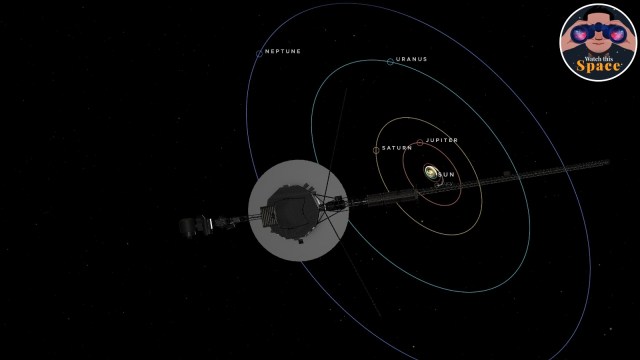- India
- International
Watch this Space: Voyager 1 goes ‘senile’ and the interstellar object lie
Voyager 1, the farthest human-made object in space, has been sending back nonsensical data since November, raising concerns about its functionality. This potential loss is more sentimental than scientific, as Voyager 1 has already made groundbreaking discoveries.
 Voyager 2 is currently the second most distant human-made object from Earth (Image credit: NASA)
Voyager 2 is currently the second most distant human-made object from Earth (Image credit: NASA)NASA’s Voyager 1 has been travelling in space for nearly 50 years and in that time, it became the first spacecraft to go into interstellar space and continues to be the man-made object farthest from the Earth. But since last November, it has been sending back nothing but “incoherent” data back to mission controllers, raising serious concerns about whether its time has ended.
Voyager 1’s demise would not be as much of a scientific loss as it would be an emotional one. For the scientific community, what is happening right now is the equivalent of watching a really old relative go senile. The spacecraft seems to have already lost its bearings and what it says does not make much sense.
“It basically stopped talking to us in a coherent manner,” said Suzanne Dodd of NASA’s Jet Propulsion Laboratory to NPR. Dodd has been the project manager for the Voyager interstellar mission since 2010.
A Voyager update: Engineers are still working to resolve a data issue on Voyager 1. We can talk to the spacecraft, and it can hear us, but it's a slow process given the spacecraft's incredible distance from Earth.
We’ll keep you informed on its status. 🤞 pic.twitter.com/qSxG0au1Nn
— NASA JPL (@NASAJPL) February 6, 2024
Apart from being the first spacecraft to venture beyond the protective heliosphere of our Sun, it also helped make many important discoveries, including a thin ring around Jupiter, two new Jovian moons, five new Saturnian moons and a new ring for the planet called the G-ring.
Voyager 1 and Voyager 2 were launched in the year 1977 to take advantage of a rare geometric alignment of the outer planets which allowed NASA to take a four-planet tour in a relatively short period of time with minimal fuel use. The layout of Jupiter, Saturn, Uranus and Neptune last seen in the 1970s and the 1980s lets a spacecraft on a special flight path swing from one planet to another without large onboard propulsion systems. The layout only happens about once in 175 years.

Rather counterintuitively, Voyager 2 launched on August 20, 1977, before Voyager 1 launched on September 5, 1977. But the latter was put on a faster and shorter trajectory. This meant that Voyager 1 reached Jupiter on March 5, 1979 and Saturn on November 12, 1980, while Voyager 2 accomplished the same feat on July 9, 1979 and August 25, 1981, respectively.
For the initially planned two-planet mission, the spacecrafts were built to last five years but with its successful achievement of its objectives and as the mission went on, NASA engineers realised that it would also be possible to do flybys of the two outermost giant planets Uranus and Neptune.
NASA claims that even if the Voyager mission had ended after Jupiter and Saturn, it would still have been enough material to “rewrite” astronomy textbooks. But the information they have returned over the past 45 years has revolutionised planetary astronomy and our understanding of the solar system.
Now, enough about things that we have sent into interstellar space, what about things that have come to Earth from there?
In 2014, a meteor also known as Interstellar meteor 1, crashed into the Earth in the Pacific Ocean. A 2019 preprint paper by Harvard astrophysicist Avi Loeb and astronomer Amir Siraj claimed that it was an interstellar object. Other astronomers already doubted this claim but in 2023, Loeb was part of an expedition in the part of the ocean where the meteor was believed to have fallen and claimed he discovered “materials of interstellar origin.”
I'm currently more than 20.4 billion kilometers (12.6 billion miles) away from Earth. But on this day in 1986, I was doing my closest flyby of Uranus. I came within 81,500 kilometers (50,600 miles) of its cloud tops! -V2 pic.twitter.com/v6bMws70BY
— NASA Voyager (@NASAVoyager) January 24, 2024
The location was derived from ground vibrations detected at the time at a seismic station in Papua New Guinea’s Manus Island. Now, a new research study led by Johns Hopkins University found that those vibrations were actually caused by a truck driving through the highway.
The research paper also concludes that the material found by Loeb and his colleagues were actually probably either bits of tiny run-of-the-mill meteorites or formed by the impact of meteorites on Earth’s surface. So we do not really have anything from interstellar space, even though it has something of ours. Two things actually — Voyager 1 and Voyager 2.
More Tech
May 05: Latest News
- 01
- 02
- 03
- 04
- 05





























